| |
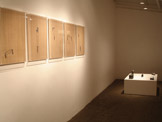
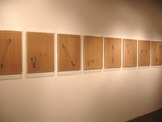
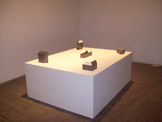
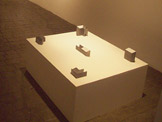
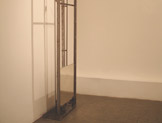

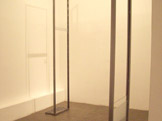
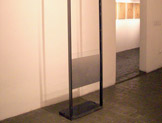
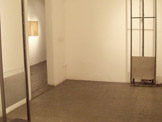
|
2008
08.10 to 14.11 - Ascensor | Eduardo Climachauska
Solol Exhibition at the Eduardo Fernandes Gallery
The Blade of Time Eduardo Climachauska presents two series of works in his second solo exhibition at Galeria Eduardo Fernandes. One includes a three sculptures/installation that represents guillotines, and the other includes drawings/paintings on wooden boards.
Due to the complexity of the proposed works, the idea of attempting to “translate” such “complexity” directed to the public interested in art through an essay or a review, in this “mediation” results in a certain difficulty to examine the possibilities not of one, but of several reactions addressed to the person observing them. Compared to other interactive works that are abundant in other art exhibitions, this work by Climachauska, on the contrary, repel the public. Fear creates a distance, in face of a cold material, loaded with violent meanings. The guillotine was an instrument used to make “justice” created during the French Revolution, at the end of the 18th century, by a French doctor by the name of Joseph Ignace Guillotin, at the beginning interested in art. His intention with this invention was to provide a less painful – and much quicker – death to those condemned to capital punishment. The doctor had the intention of providing a gentle death to all, independent of their social status. It became a popular instrument in France, which remain in use until recently, when, in 1977, it was used for the last time to carry out a sentence of capital punishment.
The “instrument” became one of the most bloody and frightful ways of taking one’s life.
At the time of the French Revolution, it attracted crowds around public squares to watch the Dantesque spectacle, gratifying their human curiosity and desire for blood.
The second series is a contrast to the first, perhaps for the lack of intentionality. It is also composed of a violent gesture – to a certain extent – compared to the first work. But now, it is loosened by the artist himself, in his action of painting or drawing on finely finished wooden boards.
The result is an absolute simplicity and it is not clear what the intention of the artist is in this act of “painting”, that is almost “banal”. He throws small quantities of paint (one single silver color) against the “pictorial” field. A controlled gesture or action, repeated twice. It remains on the edge between what we understand as being a painting and a drawing. Then, with rough and thick lines, he joins the two paint spots with a to-and-fro motion.
In observing the whole, the drawing between the plates of paint provokes an illusion, as though the traces were embodied and had depth, creating a new dimension in the two-dimensional wooden plane.
Eduardo Climachauska, born in São Paulo of Lithuanian descent, graduated in 1980 from Escola de Comunicações e Artes da Universidade de São Paulo. He has a long trajectory as an artist, expressed in several languages: installation, photography, drawing, painting and sculptures or structures that deal with the driving-force. These are the media Eduardo has been using in his works during almost 30 years. After several years, since my first encounter with the artist’s work at the Contemporary Art Museum at Universidade de São Paulo, in 1991, when the group – that also included his brother, Paulo Climachauska, and the artist Lina Kim – exhibited Três Dimensões da Objetividade (The Three Dimensions of Objectivity), it is clear some conceptual relationships in his work, during the different stages. The first sculptures and installations were pointed instruments, such as lightning rods antennas, cables, mainly made of copper.
In 2007, Eduardo showed an installation at Centro Cultural Maria Antônia that challenged our perception of stability. Sets of old wardrobes, china and crystal closets heaped up in a top corner of the exhibition room, forming a mass and linked one to the other, supported by steel cables. The sensation was instability. The structure formed seemed to be on the verge of tumbling down on those who would dare go underneath the installation. His proposals, therefore, already had a certain aggressiveness, that now is seen in these guillotines.
One of them is not frozen in its descent and remains in an unending pendulous movement. The others seemed frozen in time, at the decisive moment during the movement of the blade, downwards to the emptiness of civilization’s history. Ricardo Resende, Art Critic, São Paulo, October 2008 |